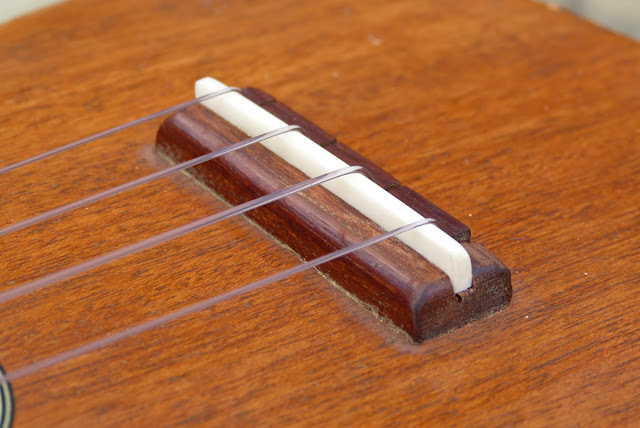1950s Harmony Mahogany Soprano Uke
This particular model is like the poster-child of Harmony uke manufacture in my eyes and it was built in various trim stylings from the 1930s until the company went out. It's a riff on a Martin style 0 uke with a similar-sized solid mahogany body, neck, and bridge and a rosewood fretboard. The construction is a little simpler and folksier inside and, of course, it's not as refined, but these little Harmony ukes do have a good, round, sweet, woody tone.
It came to me with an already-done neck reset, swapped tuners, and a weird home-made"saddle extender" installed at the bridge (ie, taller saddle popped on top), but my work was to repair a cracked area on the lower bout top (two hairlines and a seam separation), give it a fret level/dress, cut a new bone nut and saddle, and set it up. It plays easy with on-the-dot 1/16" action at the 12th fret and a straight neck. It's strung with D'Addario Titaniums which sound good on it -- but I could also imagine it sounding quite fine with slightly-heavier fluorocarbon, too.
Grr -- I forgot to take a direct picture of the cracked area on the top, but if you click on this picture to blow it up full-size you can see there are two hairlines (one extending to a little past the bridge) and a "crunch" fracture-crack at the lower-bout bass side on the top. They're all glued-up and good to go.
The new nut is bone and the tuners are recent Golden Gate units (my favorite under-$45 tuners) minus their ferrules. Note the small chip-out behind the nut.
The brass frets leveled/dressed nicely. The little extension over the body of the fretboard has some hairlines in it but it's good to go (I'm gathering they happened during the old reset work -- pretty typical for that thin rosewood to do that in handling).
The only decoration is a multi-ply binding around the soundhole.
There's a chip-out at the bridge near the G-string anchor spot, but it's good to go as well.
The finish is a semi-gloss sort of spray job (original). I gather this uke also spent most of its life inside as the "natural" color of the finish job has held-up well instead of getting darker via UV yellowing like most of these do.


















Comments